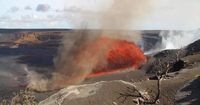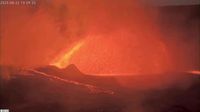On August 22, 2025, Hawaii’s Kīlauea volcano—renowned as one of the world’s most active—put on its 31st fiery display since December 2024, mesmerizing scientists, residents, and visitors alike. This latest episode, unfolding on the Big Island within Hawaiʻi Volcanoes National Park, saw lava fountains soar from the volcano’s summit crater, painting the sky with streaks of molten rock and drawing crowds eager to witness nature’s raw power up close.
According to the Hawaiian Volcano Observatory, Kīlauea began spewing fresh lava at 2:04 p.m. local time on Friday, marking yet another chapter in a continuous eruption sequence that has captivated the island for months. The eruption began with the north vent at the summit crater spattering lava in the morning, followed by an arc of lava shooting 100 feet into the air and across the crater floor by afternoon. By 2:39 p.m., the Observatory reported, “The fountains are coming out of the north vent at a 45-degree angle and would be over 500 feet high if they were straight up.”
For Kīlauea, such activity is not unusual. As BBC notes, this is the 31st eruptive episode since December 2024, underscoring the volcano’s reputation for frequent and dramatic displays. Past episodes have even produced eruptive plumes reaching up to 20,000 feet (6,000 meters) above ground level—a testament to the volcano’s immense subterranean energy.
Scientists at the U.S. Geological Survey (USGS) have been closely monitoring the ongoing activity. In their Volcanic Activity Notice issued Friday afternoon, they explained that a lower magma chamber beneath Halemaumau Crater is currently receiving magma directly from the earth’s interior at a rate of about five cubic yards per second. This influx inflates the chamber, forcing magma into an upper chamber and eventually above ground through cracks in the summit. “Magma has been using the same pathway to rise to the surface since December, making the initial release and subsequent episodes all part of the same eruption,” said Ken Hon, the scientist-in-charge at the Hawaiian Volcano Observatory.
The mechanics behind Kīlauea’s spectacular fountains are as fascinating as they are complex. As magma rises, it carries dissolved gases. When the pressure becomes great enough, the degassed magma from previous episodes is pushed aside, and the new, gas-rich magma erupts in a dramatic burst—much like a shaken Champagne bottle popping its cork. This pattern has only been observed a handful of times in the past two centuries, most notably during the 1983 eruption that featured 44 separate fountain episodes over three years. However, as University of Hawaii at Hilo geology professor Steve Lundblad remarked, “We’re still gonna have spectacular eruptions. They’re just going to be wider and not as high,” suggesting that the widening of the vent may be leading to shorter, broader fountains.
Despite the intensity of the eruption, officials have reassured the public that the activity remains contained within the summit crater, with no homes threatened. All recent activity has been confined to Hawaiʻi Volcanoes National Park, and commercial airports in Hawaii County—Kona (KOA) and Hilo (ITO)—remain unaffected. The USGS has kept the Volcano Alert Level and Aviation Color Code at WATCH and ORANGE, respectively, reflecting ongoing but localized activity. Winds from the northeast at 15-20 miles per hour have been distributing volcanic gas emissions and material to the south and southwest of the summit caldera, but no changes have been detected in the East Rift Zone or Southwest Rift Zone, according to the Observatory.
For those lucky enough to be on the island, the eruption offers a front-row seat to one of nature’s most extraordinary spectacles. Park Service volunteer Janice Wei described the experience vividly: “Every eruption feels like I am sitting in the front row at nature’s most extraordinary show.” She likened the sound of the lava fountains to “a roaring jet engine or crashing ocean waves,” adding that she can feel the heat from over a mile away.
The eruption has also provided a poignant connection to Native Hawaiian tradition. Halemaumau Crater is revered as the home of the volcano goddess Pele, and for many, the eruption is not just a geological event but a deeply spiritual one. Huihui Kanahele-Mossman, executive director of the Edith Kanakaʻole Foundation, explained the significance: “You as the dancer, you are the storyteller and you carry that history that was written in those mele forward. To be able to actually see that eruption that’s described in the mele, that’s always exciting to us and drives us and motivates us to stay in this tradition.” She described visiting the crater, delivering chants, and making offerings such as awa and fern lei, blending cultural reverence with scientific wonder.
This surge in volcanic activity has also translated into a boom in park visitation. According to park spokesperson Jessica Ferracane, visitation has risen every month in 2025, with April seeing a 49% increase compared to the same month in 2024. The allure of witnessing an active eruption has drawn both locals and tourists, though Ferracane cautions that safety is paramount. “Those wanting to go should sign up for U.S. Geological Survey alert notifications because the eruption could be over before you know it,” she advised. Visitors are urged to stay on marked trails and overlooks, as unstable cliff edges and cracks can pose serious hazards. Volcanic gas, glass, and ash are also dangers, particularly for young children and nighttime visitors, who are encouraged to bring flashlights and exercise extra caution.
While the eruption is currently contained and poses no immediate threat to communities, scientists remain vigilant. They use a network of sensors to monitor seismic tremor, ground tilt, and other signs that might indicate changes in magma movement. As Ken Hon put it, “Our job is like being a bunch of ants crawling on an elephant trying to figure out how the elephant works.” Predicting the volcano’s next move is a challenging task, and while the current eruption could end at the summit if the magma supply dwindles, history shows that Kīlauea is capable of surprising even the most seasoned experts. The 1983 eruption, for example, saw the volcano open a new vent at a lower elevation, leading to three decades of continuous activity before finally subsiding in 2018.
For now, Kīlauea continues to awe and inspire, a powerful reminder of Hawaii’s ever-changing landscape and the deep cultural ties that bind its people to the land. Whether viewed through the lens of science or tradition, each eruption writes a new chapter in the ongoing story of one of Earth’s most dynamic volcanoes.



